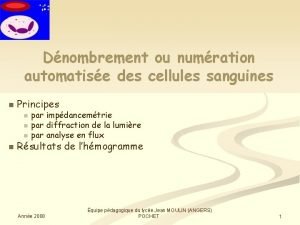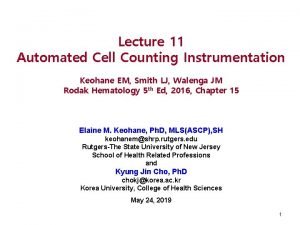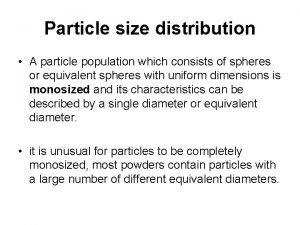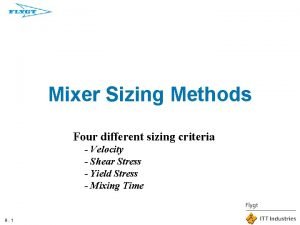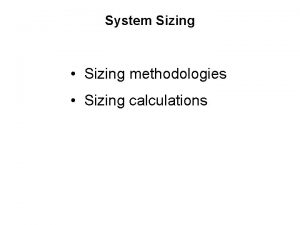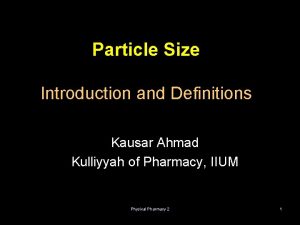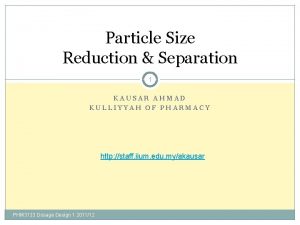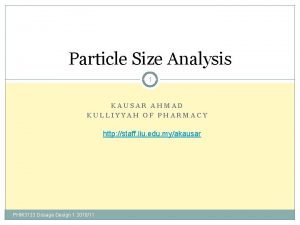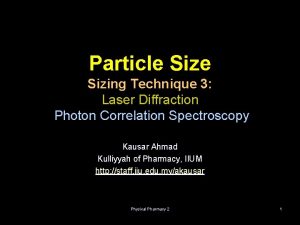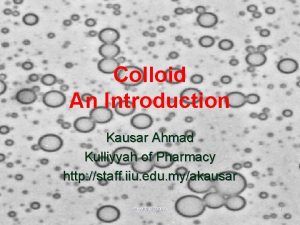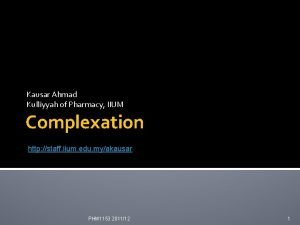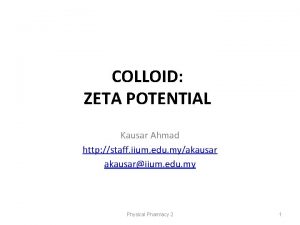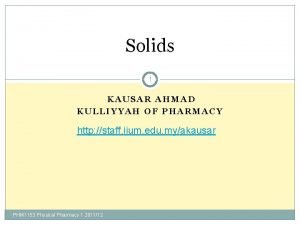Particle Sizing Technique 1 Coulter principle Kausar Ahmad
















- Slides: 16

Particle Sizing Technique 1: Coulter principle Kausar Ahmad Kulliyyah of Pharmacy, IIUM http: //staff. iiu. edu. my/akausar Physical Pharmacy 2 1

Electrical Sensing Zone Method A. k. a. the Coulter principle l Basic method of counting and sizing based on the detection and measurement of changes in electrical resistance, produced by a particle or biological cell, suspended in a conductive liquid, traversing through a small aperture. Physical Pharmacy 2 2

Wallace Coulter - Coulter orifice (1956) l (as early as 1948) - measured changes in electrical conductance as cells suspended in saline passed through a small orifice l Cells are relatively poor conductors l Blood is a suspension of cells in plasma which is a relatively good conductor l Previously it was known that the cellular fraction of blood could be estimated from the conductance of blood l As the ratio of cells to plasma increases the conductance of blood decreases Physical Pharmacy 2 3

From: http: //www. cyto. purdue. edu/flowcyt/educate/ee 520/sld 008. htm Physical Pharmacy 2 4

Principle A current, between two electrodes, create a sensing zone around the aperture When passing through the aperture, the magnitude of the current is ca. I m. A When a particle passes through the aperture, it causes changes in electrical impedance EACH particle will trigger a voltage pulse indicating a depression in current flow The magnitude of the decrease depends on size of particle Physical Pharmacy 2 5

Interpreting the results Amplitude of the pulse is proportional to the volume of the particle • Hence, can determine diameter of particle Each pulse represents one particle • Hence, can determine the number of particle • And therefore, Coulter counter………. The voltage pulses will be counted, amplified and allocated to the right size class. Physical Pharmacy 2 6

Advantages of Technique capable of counting thousands of particles per second Results are not affected by: • • Colour Composition Refractive index Or other light interaction effects Absolute sample volume. Physical Pharmacy 2 7

Converting Signals to Particle Diameter Calibrate instrument using 10 or 20 µm polystyrene standards Obtain the ‘Kd’ • The Kd is used to convert the amplitude of the pulse in volt to volume of the particle (this is a linear response) From the volume, the diameter can be calculated. Physical Pharmacy 2 8

Calibration of instrument A monodisperse standard is used Pulses on oscilloscope of uniform size Concentration used is very low so that coincidence effects are less than 2% Instrument is adjusted/calibrated to give the ‘Kd’ Physical Pharmacy 2 9

Relationship between electrical signal and volume of particle Voltage proportional to volume of particle: U = constant x V constant = r 0 if / 2 R 4 U=amplitude of voltage pulse V=particle volume r 0=electrical resistivity i= aperture current f= particle ‘shape’ factor R=aperture radius Physical Pharmacy 2 must not be dirty 10

Sample Concentration If more than one particle passes through the aperture at exactly the same time (coincidence effect), the reading is not accurate. Therefore, sample must be reasonably diluted and should be within the specified range as indicated by the instrument. Physical Pharmacy 2 11

Sample Condition It is important that only one particle passes through the aperture. There should not be any aggregation or flocculation. For detecting a stable suspension, the particles must exist as discrete individual entities. A dispersant must be used Samples dispersed in the electrolyte must be stirred during measurement, especially if it is a solid dispersion, to prevent settling. Physical Pharmacy 2 12

Aperture The aperture comes in different sizes E. g. an aperture of 100 µm can detect particles within 2 to 60 µm Outside the range, the measurement is not accurate Aperture should be clean Physical Pharmacy 2 13

Results Generated Results can be displayed in terms of number, volume, surface area against particle size. Size axis can be linear, logarithmic scale Distribution can be differential or cumulative data • Cumulative data can be oversize or undersize Physical Pharmacy 2 14

Application Counting algae Counting bacteria Counting cells In industries To standardise standards ! • To detect contaminant in petroleum • Electronic: TV screen, CRT (Dots per inch = DPI) Physical Pharmacy 2 15

References JZ Knapp, TA Barber & A Lieberman, Liquid and Surface. Borne Particle Measurement Handbook, Marcel Dekker, New York (1996). T Allen, Particle Size Measurement 4 th. Ed. , Chapman and Hall, London (1990). Beckman-Coulter Multisizer 3 operation manual (lab) Physical Pharmacy 2 16
 Kausar ahmad
Kausar ahmad Biolaxin
Biolaxin Principles of management stephen p robbins
Principles of management stephen p robbins The flow of communication
The flow of communication Pam coulter
Pam coulter Management stephen robbins
Management stephen robbins Idc hemogramme
Idc hemogramme Coulter
Coulter Cumulative particle size distribution curve
Cumulative particle size distribution curve Robbins and coulter 2007
Robbins and coulter 2007 Basic principle of magnetic particle testing
Basic principle of magnetic particle testing Tall grande
Tall grande Double lumen tube sizing
Double lumen tube sizing Position sizing techniques
Position sizing techniques Mixer sizing calculations
Mixer sizing calculations Me 444
Me 444 Watchman sizing chart
Watchman sizing chart






